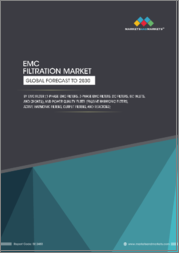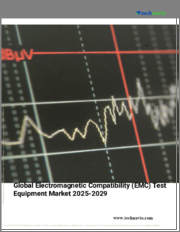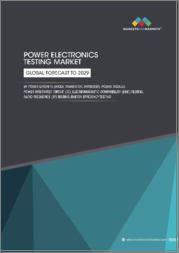
|
시장보고서
상품코드
1809922
EMI 테스트 시스템 시장 : 컴포넌트별, 시험 유형별, 산업별 - 세계 예측(2025-2030년)EMI Test System Market by Components, Testing Type, Industry - Global Forecast 2025-2030 |
||||||
EMI 테스트 시스템 시장의 2024년 시장 규모는 33억 5,000만 달러로 평가되었습니다. 2025년에는 35억 6,000만 달러에 이르고, CAGR 6.66%로 성장하여 2030년에는 49억 3,000만 달러에 달할 것으로 예측됩니다.
| 주요 시장 통계 | |
|---|---|
| 기준 연도 : 2024년 | 33억 5,000만 달러 |
| 추정 연도 : 2025년 | 35억 6,000만 달러 |
| 예측 연도 : 2030년 | 49억 3,000만 달러 |
| CAGR(%) | 6.66% |
다양한 기술 분야에서 제품의 신뢰성을 높이고 안전한 성능을 보장하는 데 있어 EMI 테스트의 중요한 역할에 대해 알아보십시오.
EMI 테스트는 상호연결이 진행되는 기술 환경 속에서 전자 시스템의 신뢰성과 안전성을 확보하기 위한 기초 프로세스로 부상하고 있습니다. 디바이스가 급증하고 무선 통신 표준이 진화함에 따라 간섭에 대한 내성을 정확하게 측정, 완화 및 인증하는 능력은 필수불가결한 요소로 자리 잡고 있습니다. 이 소개에서는 설계 초기 단계부터 최종 생산에 이르기까지 성능 사양이 타협 없이 충족되도록 보장하기 위해 체계적인 검증의 중요성을 강조함으로써 그 단계를 설정합니다.
EMI 테스트 표준을 재정의하고 업계 전반의 혁신을 가속화하는 급속한 기술 발전과 규제 진화를 탐구합니다.
EMI 테스트 환경은 급속한 기술 혁신과 진화하는 규제 프레임워크로 인해 큰 변화를 겪고 있습니다. 고주파 디지털 회로의 발전은 beyond 5G 이후의 출현과 함께 새로운 간섭 벡터를 도입하고 감도 요구 사항을 높이고 있습니다. 전 세계 시험소는 현재 밀리미터파 주파수에서 복잡한 신호 상호작용을 특성화할 수 있는 최첨단 계측기를 도입하고 있으며, 이는 기존의 협대역 방식에서 비약적으로 발전하고 있습니다.
미국의 최근 관세 조치가 공급망에 미치는 영향 분석, EMI 테스트 생태계의 생산 비용 및 전략적 조달
미국의 새로운 관세 구조의 도입은 EMI 테스트 생태계에 눈에 띄는 복잡성을 가져왔습니다. 정밀 증폭기, 고성능 필터, 특수 센서 등 중요한 테스트 장비 부품공급망은 수입 관세 인상에 직면해 있습니다. 그 결과, 거래처 상표 제품 제조업체와 독립 연구소는 비용 상승을 완화하기 위해 조달 전략을 재평가하고 있으며, 그 결과 첨단 테스트 플랫폼에 대한 투자 결정에 영향을 미치고 있습니다.
EMI 테스트의 다면적인 세분화 상황을 매핑하여 정보에 입각한 전략을 위한 구성 요소별, 테스트 유형별, 산업별 니즈를 파악할 수 있습니다.
EMI 테스트 시장은 대상 서비스 제공 및 기술 투자에 대한 정보를 제공하는 다양한 세분화가 특징입니다. 구성 요소 수준에서 하드웨어 솔루션에는 증폭기, 분석기, 안테나, 필터, 오실로스코프, 센서 등이 포함되며, 각각 신호 특성화 및 간섭파 완화에 뚜렷한 역할을 수행합니다. 이러한 물리적 장비를 보완하는 소프트웨어 플랫폼은 강력한 데이터 분석 및 시뮬레이션 기능을 제공하여 엔지니어가 간섭 패턴을 시각화하고 비용이 많이 드는 시제품 제작에 착수하기 전에 설계를 반복적으로 개선할 수 있도록 지원합니다.
전 세계 주요 지역 시장 성장 촉진요인, 과제 및 성장 기회를 파악하여 EMI 테스트의 지역적 역학에 대한 이해를 돕습니다.
지역적 역학은 경제적, 규제적, 기술적 요인의 결합으로 EMI 테스트의 궤적을 형성하고 있습니다. 북미와 남미에서는 진보적인 표준과 성숙한 시험소 생태계를 바탕으로 한 북미 혁신의 중심지가 차세대 무선 시험 및 자동차 시험 수요를 주도하고 있습니다. 중남미 시장에서는 산업 현대화 및 디지털 혁신 노력으로 인해 컴플라이언스 및 개발 테스트 서비스 채택이 가속화되고 있으며, 이는 새로운 비즈니스 기회를 창출하고 있습니다.
선구적인 기술 및 협력적 생태계, 전략적 파트너십을 통해 EMI 테스트의 미래를 만들어가는 업계 선도 기업 프로파일링
EMI 테스트 영역은 기술력, 종합적인 서비스 포트폴리오, 전략적 제휴를 통해 눈에 띄는 몇몇 주요 기업들에 의해 형성되고 있습니다. 주요 업체들은 고속 데이터 분석기부터 예측 모델링 및 적응형 측정 루틴을 제공하는 통합 소프트웨어 에코시스템에 이르기까지 차세대 테스트 장비에 지속적으로 투자하고 있습니다. 표준화 단체와의 협력과 컨소시엄 참여를 통해 이들 기업은 새로운 규제에 영향을 미치고 최첨단 프로토콜을 자사 제품에 도입할 수 있습니다.
업계 리더들이 새로운 EMI 테스트 트렌드를 활용하기 위한 전략적 로드맵을 그려 운영의 민첩성을 높이고 지속 가능한 경쟁 우위를 확보할 수 있도록 지원합니다.
진화하는 EMI 테스트 환경을 탐색하고 활용하기 위해 업계 리더들은 적극적인 전략적 아젠다를 채택해야 합니다. 먼저, 자동화된 테스트 오케스트레이션과 머신러닝 기반 분석을 기존 워크플로우에 통합하여 사이클 타임을 단축하고 진단에 대한 심층적인 통찰력을 확보하여 설계팀이 간섭 문제가 심각해지기 전에 선제적으로 대응할 수 있도록 돕습니다.
1차 조사 및 2차 데이터 검증, 엄격한 분석 기법을 통해 신뢰할 수 있는 시장 인사이트를 확보하기 위한 견고하고 투명한 조사 프레임워크에 대해 자세히 알아보자.
이 분석의 기초가 되는 설문조사는 업계 이해관계자들과의 엄격한 1차 조사와 종합적인 2차 데이터 검증을 결합하여 이루어졌습니다. 먼저, 최고 경영자, 기술 책임자, 시험소 관리자와의 심층 인터뷰를 통해 EMI 테스트 분야의 현재 과제, 기술 채택 촉진요인, 전략적 우선순위에 대한 질적 관점을 제공했습니다.
진화하는 EMI 테스트 시장 환경을 탐색하기 위해 새로운 패턴의 전략적 과제와 미래지향적 관점을 통합한 결론적 통찰력을 제공합니다.
EMI 테스트에 영향을 미치는 다면적인 촉진요인과 동향을 종합하면 몇 가지 종합적인 주제가 떠오릅니다. 끊임없는 기술 혁신의 속도와 역동적인 규제 환경은 미래 지향적인 용도과 최신 규정 준수 지침에 부합하는 적응형 테스트 전략의 필요성을 강조하고 있습니다. 동시에 진화하는 관세 환경과 공급망 구성의 변화는 운영의 유연성과 전략적 조달 통찰력을 요구하고 있습니다.
목차
제1장 서문
제2장 조사 방법
제3장 주요 요약
제4장 시장 개요
제5장 시장 역학
제6장 시장 인사이트
- Porter's Five Forces 분석
- PESTEL 분석
제7장 미국 관세의 누적 영향 2025
제8장 EMI 테스트 시스템 시장 : 컴포넌트별
- 하드웨어
- 앰프
- 애널라이저
- 안테나
- 필터
- 오실로스코프
- 센서
- 소프트웨어
- 데이터 분석 소프트웨어
- 시뮬레이션 소프트웨어
제9장 EMI 테스트 시스템 시장 : 시험 유형별
- 컴플라이언스 시험
- 개발 시험
- 사전 컴플라이언스 시험
- 생산 시험
제10장 EMI 테스트 시스템 시장 : 산업별
- 자동차
- ADAS
- 인포테인먼트 시스템
- 소비자 일렉트로닉스
- 홈 디바이스
- 웨어러블 디바이스
- 방위
- 산업
- 자동화 시스템
- 기계 제어 시스템
- 의료
- 의료용 이미징 디바이스
- 웨어러블 헬스케어 디바이스
- 연구 및 학술기관
- 반도체
- 통신
- 네트워크 장비
- 무선 기술
제11장 아메리카의 EMI 테스트 시스템 시장
- 미국
- 캐나다
- 멕시코
- 브라질
- 아르헨티나
제12장 유럽, 중동 및 아프리카의 EMI 테스트 시스템 시장
- 영국
- 독일
- 프랑스
- 러시아
- 이탈리아
- 스페인
- 아랍에미리트(UAE)
- 사우디아라비아
- 남아프리카공화국
- 덴마크
- 네덜란드
- 카타르
- 핀란드
- 스웨덴
- 나이지리아
- 이집트
- 튀르키예
- 이스라엘
- 노르웨이
- 폴란드
- 스위스
제13장 아시아태평양의 EMI 테스트 시스템 시장
- 중국
- 인도
- 일본
- 호주
- 한국
- 인도네시아
- 태국
- 필리핀
- 말레이시아
- 싱가포르
- 베트남
- 대만
제14장 경쟁 구도
- 시장 점유율 분석, 2024
- FPNV 포지셔닝 매트릭스, 2024
- 경쟁 분석
- Aaronia AG
- Anritsu Corporation
- Com-Power Corporation
- DT&C Vina
- Frankonia Group
- GAUSS INSTRUMENTS GmbH
- Intertek Group PLC
- Keysight Technologies, Inc.
- Lisun group
- Nemko
- Rohde & Schwarz GmbH & Co. KG
- Schaffner Group
- Scientific Mes-Technik Pvt. Ltd
- TDK Corporation
- Tektronix, Inc.
- Testforce USA Inc.
- Astra Microwave Products Ltd.
- Extreme Engineering Solutions, Inc
- Tata Advanced Systems Limited
- Tehencom company
- NexorTest Techonogies Pvt Ltd.
제15장 리서치 AI
제16장 리서치 통계
제17장 리서치 컨택트
제18장 리서치 기사
제19장 부록
LSH 25.09.22The EMI Test System Market was valued at USD 3.35 billion in 2024 and is projected to grow to USD 3.56 billion in 2025, with a CAGR of 6.66%, reaching USD 4.93 billion by 2030.
| KEY MARKET STATISTICS | |
|---|---|
| Base Year [2024] | USD 3.35 billion |
| Estimated Year [2025] | USD 3.56 billion |
| Forecast Year [2030] | USD 4.93 billion |
| CAGR (%) | 6.66% |
Unveiling the Critical Role of Electromagnetic Interference Testing in Driving Product Reliability and Ensuring Safe Performance Across Diverse Technology Sectors
Electromagnetic interference testing has emerged as a foundational process for ensuring that electronic systems operate reliably and safely within an increasingly interconnected technological landscape. As devices proliferate and wireless communication standards evolve, the ability to accurately measure, mitigate, and certify immunity against interference becomes non-negotiable. This introduction sets the stage by highlighting the importance of systematic validation-from the earliest design stages through to final production-to guarantee that performance specifications are met without compromise.
In today's environment, cross-sector applications propel the requirement for rigorous testing protocols. From automotive advanced driver assistance systems to medical imaging equipment, each end use demands exacting standards to maintain fidelity under real-world electromagnetic conditions. Wireless infrastructures in telecommunications further amplify the criticality of stringent compliance checks, where even marginal signal disruptions can degrade network integrity and user experience.
Driving this surge are compact form factors and the integration of multiple wireless technologies within a single device, compelling product designers to adopt robust electromagnetic interference testing strategies. Concurrently, international regulations and industry consortia continually tighten permissible emission and susceptibility thresholds, reinforcing the strategic significance of early-stage testing. As such, organizations that embed comprehensive EMI validation into their product development cycle gain a competitive edge by reducing time to market, avoiding costly recalls, and safeguarding brand reputation.
Transitioning from foundational considerations, the following analysis delves into transformative shifts reshaping the market's contours and how stakeholders can harness these changes for optimal impact.
Exploring the Rapid Technological Advancements and Regulatory Evolutions that Are Redefining EMI Testing Standards and Accelerating Innovation Across Industries
The electromagnetic interference testing landscape has undergone a profound metamorphosis, driven by rapid technological breakthroughs and evolving regulatory frameworks. Advances in high-frequency digital circuits, combined with the emergence of 5G and beyond, have introduced new interference vectors and heightened sensitivity requirements. Test laboratories worldwide now deploy state-of-the-art instrumentation capable of characterizing complex signal interactions at millimeter-wave frequencies, a leap forward from traditional narrowband methods.
Simultaneously, regulatory bodies across major markets are updating standards to address IoT proliferation and autonomous systems. These regulatory revisions often accelerate the adoption of pre-compliance testing in development phases, enabling design teams to anticipate potential non-conformities early on. Meanwhile, collaborative alliances between industry consortia and test equipment manufacturers foster co-innovation, leading to protocol harmonization and the creation of tailored test suites for specialized applications.
Moreover, digital transformation efforts within testing facilities have catalyzed the deployment of automated test sequences and remote monitoring platforms. This shift not only increases throughput but also delivers data-driven insights for continuous process optimization. As a result, stakeholders benefit from accelerated validation cycles and greater confidence in system robustness.
Looking ahead, these transformative shifts underscore the imperative to align test strategies with both technological evolution and regulatory agility, ensuring that enterprises remain at the vanguard of quality assurance and product reliability.
Analyzing the Far-reaching Consequences of Recent United States Tariff Measures on Supply Chains Production Costs and Strategic Sourcing in the EMI Testing Ecosystem
The implementation of new tariff structures by the United States has introduced notable complexities within the electromagnetic interference testing ecosystem. Supply chains for critical test equipment components, such as precision amplifiers, high-performance filters, and specialized sensors, have faced elevated import duties. Consequently, original equipment manufacturers and independent laboratories are reevaluating procurement strategies to mitigate cost increases, which in turn influences investment decisions in advanced testing platforms.
These tariff-driven adjustments have ripple effects that extend beyond direct equipment costs. Companies are exploring alternative sourcing from regions with preferential trade agreements or reshoring selective manufacturing processes to reduce exposure to fluctuating import taxes. However, these strategic shifts necessitate rigorous vendor qualification and recalibration of logistics networks to preserve lead times and maintain service reliability.
Moreover, heightened production expenses can compress margins, especially for small to medium-sized testing facilities. In response, many providers are emphasizing value-added services-such as customized test development, software integration, and consulting-to differentiate offerings and justify premium pricing. This trend reflects a broader industry pivot toward holistic solutions that encompass end-to-end compliance support rather than stand-alone equipment rental or testing fees.
Overall, the evolving tariff landscape compels stakeholders to adopt flexible sourcing strategies, optimize operational efficiencies, and reinforce collaborative partnerships. These measures are integral to sustaining competitiveness and ensuring uninterrupted access to essential testing resources in an era of dynamic trade policies.
Mapping the Multifaceted Segmentation Landscape of EMI Testing to Reveal Component Testing Variations Testing Types and Industry-specific Validation Needs for Informed Strategy
The electromagnetic interference testing market is characterized by a rich tapestry of segmentation that informs targeted service offerings and technology investments. At the component level, hardware solutions encompass an array of amplifiers, analyzers, antennas, filters, oscilloscopes, and sensors, each playing a distinct role in signal characterization and disturbance mitigation. Complementing these physical instruments, software platforms deliver powerful capabilities in data analysis and simulation, enabling engineers to visualize interference patterns and iteratively refine their designs before committing to costly prototypes.
Testing types further diversify the landscape, ranging from compliance evaluations that confirm adherence to regulatory benchmarks, to developmental assessments that guide product optimization. Pre-compliance testing has emerged as a critical checkpoint, allowing teams to detect potential emissions or susceptibility issues early in the design cycle. Upon entering production phases, high-volume testing protocols ensure batch consistency and operational reliability, reinforcing quality assurance across the manufacturing continuum.
Industry verticals exert unique demands on EMI testing strategies. The automotive sector requires rigorous validation for advanced driver assistance and infotainment systems, where electromagnetic disturbances can compromise safety-critical functions. In consumer electronics, home devices and wearable gadgets demand compact test solutions that reflect their form factor constraints. Industrial automation and machinery control systems must withstand harsh electromagnetic environments, while medical imaging and wearable healthcare devices face stringent regulatory scrutiny. Telecommunications network equipment and wireless technologies drive continuous innovation in test methodologies to support higher data rates and spectrum efficiency.
By weaving together insights across these dimensions, stakeholders can craft precision-tailored EMI testing protocols that align with their product portfolios, risk thresholds, and performance imperatives.
Illuminating Regional Dynamics in Electromagnetic Interference Testing by Unpacking Unique Market Drivers Challenges and Growth Opportunities Across Major Global Territories
Regional dynamics shape the trajectory of electromagnetic interference testing through a confluence of economic, regulatory, and technological factors. In the Americas, innovation hubs in North America drive demand for next-generation wireless and automotive testing, supported by progressive standards and a mature ecosystem of test laboratories. Latin American markets contribute emerging opportunities as industrial modernization and digital transformation initiatives accelerate the adoption of compliance and developmental testing services.
Across Europe, the Middle East, and Africa, regulatory harmonization efforts, such as the EMC Directive, establish a cohesive framework that facilitates cross-border equipment trade. Robust research institutions and industrial conglomerates in Western Europe lead the charge on advanced test methodologies, while Gulf Cooperation Council nations invest in high-capacity laboratories to support burgeoning telecommunications infrastructure. In Africa, growth trajectories in mining, energy, and telecommunications signal expanding prospects for localized testing services.
The Asia-Pacific region represents a nexus of manufacturing prowess and technological R&D. East Asian economies anchor the landscape with high-volume production of electronic components, requiring extensive pre-compliance and compliance testing. South Asian markets, buoyed by government-led digital adoption schemes, are rapidly scaling testing infrastructures. Meanwhile, Southeast Asian nations blend cost-sensitive service models with an increasing appetite for sophisticated simulation and automated testing platforms.
Collectively, these regional insights underscore the importance of geographic specialization and localized partnerships in delivering efficient, compliant, and cost-effective electromagnetic interference testing solutions.
Profiling Industry-leading Entities Shaping the Future of Electromagnetic Interference Testing Through Pioneering Technologies Collaborative Ecosystems and Strategic Partnerships
The electromagnetic interference testing domain is shaped by several leading entities distinguished by their technological prowess, comprehensive service portfolios, and strategic alliances. Key providers consistently invest in next-generation test equipment, from high-speed data analyzers to integrated software ecosystems that offer predictive modeling and adaptive measurement routines. Collaboration with standards bodies and participation in consortia enable these companies to influence emerging regulations and incorporate cutting-edge protocols into their offerings.
Partnerships with research institutions and component manufacturers further augment competitive positioning. By co-developing customized test chambers and specialized sensor arrays, top firms deliver tailored solutions for industry-specific challenges. Additionally, strategic acquisitions expand global footprints, granting access to regional expertise and broadening service capabilities across geographic markets.
Service differentiation often arises through value-added consulting, training programs, and turnkey laboratory management services. Leading players offer immersive workshops on electromagnetic compatibility best practices, equipping customer teams with the skills needed to optimize design processes. Meanwhile, fully managed test facilities cater to clients seeking end-to-end compliance support without the overhead of in-house infrastructure.
Through these multifaceted approaches-encompassing innovation, collaboration, and customer-centric service models-the foremost companies are orchestrating the future direction of electromagnetic interference testing, setting new benchmarks for performance and reliability.
Charting a Strategic Roadmap for Industry Leaders to Capitalize on Emerging EMI Testing Trends Enhance Operational Agility and Foster Sustainable Competitive Advantage
To navigate and capitalize on the evolving electromagnetic interference testing environment, industry leaders must adopt a proactive strategic agenda. First, integrating automated test orchestration and machine learning-based analytics into existing workflows will yield faster cycle times and deeper diagnostic insights, enabling design teams to preempt interference issues before they escalate.
Next, diversifying supply chains through multi-sourcing arrangements and regional vendor partnerships can mitigate tariff-induced cost pressures and reduce lead-time uncertainties. Organizations should also leverage modular test platforms that can be swiftly reconfigured to address emerging frequency bands and novel communication protocols, thereby preserving flexibility amidst rapid technological change.
Enhancing value propositions through bundled service offerings-combining hardware rental, software simulation, and expert consulting-will differentiate providers in a competitive marketplace. Clients increasingly seek end-to-end solutions that streamline compliance journeys and accelerate product launches. Investing in digital collaboration portals and remote testing capabilities will further reinforce client engagement and operational resilience.
Finally, establishing cross-functional centers of excellence focused on electromagnetic compatibility best practices promotes knowledge sharing and continuous process improvement. By fostering a culture of innovation and embedding compliance requirements early in the design cycle, organizations can elevate product quality while maintaining agile development timelines.
Detailing a Robust and Transparent Research Framework Employing Primary Interviews Secondary Data Validation and Rigorous Analytical Techniques to Ensure Credible Market Insights
The research underpinning this analysis combines rigorous primary interaction with industry stakeholders and comprehensive secondary data validation. Initially, in-depth interviews with top executives, technical directors, and laboratory managers provided qualitative perspectives on current challenges, technology adoption drivers, and strategic priorities within the electromagnetic interference testing sector.
Subsequent data collection involved the examination of regulatory publications, patent filings, industry white papers, and corporate sustainability reports to quantify technology readiness levels and benchmark best practices. Publicly available standards documentation and compliance guidelines were systematically reviewed to map evolving requirements across major global markets.
A triangulation approach ensured the convergence of primary insights and secondary evidence, thereby enhancing the credibility and robustness of findings. Advanced analytical techniques, including trend mapping, gap analysis, and scenario planning, were applied to interpret data patterns and forecast strategic imperatives. Moreover, continuous engagement with domain experts allowed for iterative validation of assumptions and refinement of conclusions.
This multi-step methodology, anchored in transparency and methodological rigor, ensures that the resulting market intelligence offers actionable clarity and a comprehensive view of the forces shaping the electromagnetic interference testing landscape.
Concluding Insights Synthesizing Emerging Patterns Strategic Imperatives and Forward-looking Perspectives to Navigate the Evolving Electromagnetic Interference Testing Market Landscape
In synthesizing the multifaceted drivers and trends influencing electromagnetic interference testing, several overarching themes emerge. The relentless pace of technological innovation, coupled with dynamic regulatory environments, underscores the need for adaptive test strategies that align with both future-bound applications and immediate compliance mandates. Simultaneously, evolving tariff landscapes and shifting supply chain configurations demand operational flexibility and strategic sourcing acumen.
As segmentation insights illuminate the distinct requirements across hardware, software, testing types, and industry verticals, it becomes clear that a one-size-fits-all approach is no longer tenable. Instead, successful organizations will tailor their service portfolios to meet the nuanced demands of automotive safety systems, consumer wearable devices, industrial automation, medical imaging, and telecommunications infrastructure alike.
Regionally, the interplay between mature markets and emerging territories highlights the importance of localized partnerships and customized offerings, ensuring that testing solutions are not only technically sound but also culturally and economically attuned to specific market realities.
Collectively, these insights chart a path forward for stakeholders seeking to reinforce product reliability, accelerate innovation cycles, and maintain regulatory compliance. By embracing strategic agility and investing in integrated test frameworks, organizations can unlock sustainable competitive advantages in the complex and continually evolving EMI testing arena.
Table of Contents
1. Preface
- 1.1. Objectives of the Study
- 1.2. Market Segmentation & Coverage
- 1.3. Years Considered for the Study
- 1.4. Currency & Pricing
- 1.5. Language
- 1.6. Stakeholders
2. Research Methodology
- 2.1. Define: Research Objective
- 2.2. Determine: Research Design
- 2.3. Prepare: Research Instrument
- 2.4. Collect: Data Source
- 2.5. Analyze: Data Interpretation
- 2.6. Formulate: Data Verification
- 2.7. Publish: Research Report
- 2.8. Repeat: Report Update
3. Executive Summary
4. Market Overview
- 4.1. Introduction
- 4.2. Market Sizing & Forecasting
5. Market Dynamics
- 5.1. Increasing adoption of AI-driven EMI test automation to accelerate compliance workflows
- 5.2. Integration of real-time spectrum monitoring and cloud analytics in EMI testing platforms
- 5.3. Rising demand for compact emi chambers optimized for 5g and iot device certification
- 5.4. Expansion of remote emi test capabilities with virtual control and data sharing over networks
- 5.5. Consolidation of emi test system vendors driving modular hardware and software interoperability
- 5.6. Integration of machine learning algorithms enhances predictive EMI fault detection and reduces time to resolution in production testing
- 5.7. Cloud-based EMI data management platforms streamline test report generation and enable remote collaboration for global engineering teams
6. Market Insights
- 6.1. Porter's Five Forces Analysis
- 6.2. PESTLE Analysis
7. Cumulative Impact of United States Tariffs 2025
8. EMI Test System Market, by Components
- 8.1. Introduction
- 8.2. Hardware
- 8.2.1. Amplifiers
- 8.2.2. Analyzer
- 8.2.3. Antennas
- 8.2.4. Filters
- 8.2.5. Oscilloscopes
- 8.2.6. Sensors
- 8.3. Software
- 8.3.1. Data Analysis Software
- 8.3.2. Simulation Software
9. EMI Test System Market, by Testing Type
- 9.1. Introduction
- 9.2. Compliance Testing
- 9.3. Developmental Testing
- 9.4. Pre-compliance Testing
- 9.5. Production Testing
10. EMI Test System Market, by Industry
- 10.1. Introduction
- 10.2. Automotive
- 10.2.1. Advanced Driver Assistance Systems
- 10.2.2. Infotainment Systems
- 10.3. Consumer Electronics
- 10.3.1. Home Devices
- 10.3.2. Wearable Devices
- 10.4. Defense
- 10.5. Industrial
- 10.5.1. Automation Systems
- 10.5.2. Machinery Control Systems
- 10.6. Medical
- 10.6.1. Medical Imaging Devices
- 10.6.2. Wearable Healthcare Devices
- 10.7. Research & Academic Institutions
- 10.8. Semiconductors
- 10.9. Telecommunications
- 10.9.1. Network Equipment
- 10.9.2. Wireless Technologies
11. Americas EMI Test System Market
- 11.1. Introduction
- 11.2. United States
- 11.3. Canada
- 11.4. Mexico
- 11.5. Brazil
- 11.6. Argentina
12. Europe, Middle East & Africa EMI Test System Market
- 12.1. Introduction
- 12.2. United Kingdom
- 12.3. Germany
- 12.4. France
- 12.5. Russia
- 12.6. Italy
- 12.7. Spain
- 12.8. United Arab Emirates
- 12.9. Saudi Arabia
- 12.10. South Africa
- 12.11. Denmark
- 12.12. Netherlands
- 12.13. Qatar
- 12.14. Finland
- 12.15. Sweden
- 12.16. Nigeria
- 12.17. Egypt
- 12.18. Turkey
- 12.19. Israel
- 12.20. Norway
- 12.21. Poland
- 12.22. Switzerland
13. Asia-Pacific EMI Test System Market
- 13.1. Introduction
- 13.2. China
- 13.3. India
- 13.4. Japan
- 13.5. Australia
- 13.6. South Korea
- 13.7. Indonesia
- 13.8. Thailand
- 13.9. Philippines
- 13.10. Malaysia
- 13.11. Singapore
- 13.12. Vietnam
- 13.13. Taiwan
14. Competitive Landscape
- 14.1. Market Share Analysis, 2024
- 14.2. FPNV Positioning Matrix, 2024
- 14.3. Competitive Analysis
- 14.3.1. Aaronia AG
- 14.3.2. Anritsu Corporation
- 14.3.3. Com-Power Corporation
- 14.3.4. DT&C Vina
- 14.3.5. Frankonia Group
- 14.3.6. GAUSS INSTRUMENTS GmbH
- 14.3.7. Intertek Group PLC
- 14.3.8. Keysight Technologies, Inc.
- 14.3.9. Lisun group
- 14.3.10. Nemko
- 14.3.11. Rohde & Schwarz GmbH & Co. KG
- 14.3.12. Schaffner Group
- 14.3.13. Scientific Mes-Technik Pvt. Ltd
- 14.3.14. TDK Corporation
- 14.3.15. Tektronix, Inc.
- 14.3.16. Testforce USA Inc.
- 14.3.17. Astra Microwave Products Ltd.
- 14.3.18. Extreme Engineering Solutions, Inc
- 14.3.19. Tata Advanced Systems Limited
- 14.3.20. Tehencom company
- 14.3.21. NexorTest Techonogies Pvt Ltd.



















